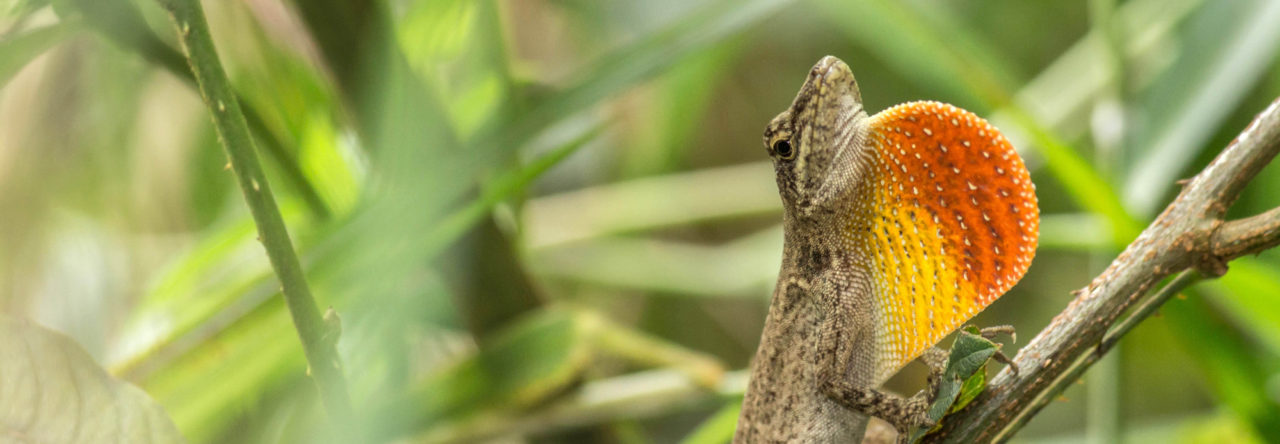![A male green anole flashes its dewlap in a territorial display. Males flaunt the red throat fan to challenge other males. [Photo by Tom Jenssen]](https://i0.wp.com/www.gannett-cdn.com/presto/2021/04/27/NTTN/6cd12f55-47f2-44a2-9328-c9ab58ededa9-05-02-21_Anolis_carolinensis_Tom_Jenssen.png?w=629&ssl=1)
One of the most commonly seen lizards in the Southern states is the green anole, also known as North American green anole or Carolina anole. (Its scientific name is Anolis carolinensis.) Although more than 400 species of anoles are known to science, the green anole is the only one native to the United States. Most people appreciate seeing them in their yards.
Q. A type of lizard we have in Birmingham, Alabama, is sometimes green and sometimes brown. I know it is not two different kinds of lizard because I have watched one change from brown to green. Are these a type of chameleon that can change skin color to match their surroundings?
A. No. Anoles are in a different family of lizards from Old World chameleons. Those are the ones famous for being able to change skin color based on the background, thus creating a true camouflage. In green anoles, color change is a response to external factors, such as temperature and humidity. It may also be influenced by hormonal changes. Whether lizards experience emotions comparable to humans remains a mystery. Researchers continue to investigate why anoles change color, as well as what purpose that change serves for the individual lizard. Most anoles found hidden under bark or leaves on cool days will be brown. If you pick up a brown one and hold it, it will usually turn green.
To learn more, I contacted Tom Jenssen, an expert on the subject of color-changing behavior in green anoles. During his career as a professor at Virginia Tech, Jenssen observed thousands of green anoles while conducting research on the species.
His observations confirmed categorically that the color of a green anole has nothing to do with what the lizard is standing on. One on a green leaf can be brown; one on dark soil can be green. He indicated that factors causing a green anole to exhibit the brown color phase are not completely understood, but he explained the biological mechanism: “Color-shifting comes from melanophore activity over a sub-dermal layer whose structure reflects green wave lengths.”
In other words, the concentration of black or brown pigment cells determines the color exhibited. If the pigment cells are large, they obscure a lower level in the skin that reflects green light. When the cells are concentrated, the lizard looks dark brown, mottled brown or even like a bad bruise of blotchy brown and olive-green. If the pigment cells contract in size, the lower level is exposed, and the lizard appears green.
He further noted that the activity of pigment cells and their concentration are controlled by the endocrine system, the glands that affect hormones and mood changes for many animals.
The remaining biological mystery: What triggers the endocrine system to cause the pigment cells to contract or expand? Body color in anoles is highly complex with no simple answer for why an individual is a particular color at any given time. Social interactions with other lizards may be responsible in some cases. Brown coloration could possibly result in faster warming of the body on a cool sunny day.
Q. Why do these lizards that can change from brown to green sometimes have a bright red throat?
A. Male green anoles use the vivid red throat fan, or dewlap, to challenge other male anoles and sometimes even other animals. The dewlap display is often accompanied by push-ups and head-bobbing. An invasive species from Cuba, the brown anole, now found in Florida, Georgia and Alabama, has an orange dewlap. Next time you see a green anole displaying a red throat, take a moment to watch its performance. Who is its audience? Is it another anole in the vicinity — or is it you?
Native green anoles are completely harmless and offer fun outdoor entertainment. Enjoy watching them stalk bugs and interact with each other. They are indicative of a healthy environment and deserve our appreciation wherever we find them.
Whit Gibbons is professor of zoology and senior biologist at the University of Georgia’s Savannah River Ecology Laboratory. If you have an environmental question or comment, e-mail ecoviews@srel.edu.

- Evolution in Real Time on Lizard Island - March 23, 2025
- Spider Snags Adult Anolis osa - March 22, 2025
- An Homage to the Green Anoles of New Orleans - March 21, 2025


1 Pingback